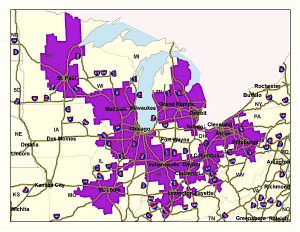Metro-East may become part of Midwest ‘traffic megaregion’
By Bob Pieper For Chronicle Media — September 28, 2016
Flowchart shows the different integrated sectors that go into developing traffic patters and future planning. (Image courtesy of U.S. Department of Transportation)
Greater St. Louis, including Metro-East, would represent the southernmost point in a massive midwestern “traffic megaregion,” now being considered by the U.S. Department of Transportation.
The midwestern megaregion, defined by the DOT as a large network of urban clusters, is one of eleven coordinated transportation districts envisioned by the department across the nation. They include two California megaregions, encompassing the greater Los Angeles and greater San Francisco areas, as well as a northeastern seaboard megaregion extending from southern Maine through Boston and New York City to the greater Washington D.C. area.
The Midwestern region would encompass the largest geographic area, taking in parts of eight states and extending into Canada. It could also potentially be the most strategically important, linking existing shipping routes between Europe and U.S. ( by way of Lake Michigan) with planned shipping routes between the U.S. and the Far East ( by way of the Mississippi River).
The megaregions would also provide infrastructure to facilitate implementation of high tech transportation systems such as autonomous vehicles, NextGen aircraft tracking systems, robotic freight handling systems, and real time travel information, according to the DOT.
Spurred in part by a 1977 study, “National Transportation: Trends and Choices (to the year 2000),” the traffic megaregion proposal is outlined in the DOT’s “Beyond Traffic: U.S. Department of Transportation’s 30-Year Framework for the Future” planning document (www.transportation.gov/BeyondTraffic), released in February 2015, and a related “Blue Paper.”
A number of major St. Louis and Metro-East development initiatives — including the East-West Gateway Council of Government’s Connected 2045 road improvement program, the Chicago-Metro-East high-speed rail line, the Bi-State Development Agency’s planned St. Louis Freightway, Granite City’s America’s Central Port District, and Edwardsville’s I-55 Corridor warehousing center — appear consistent with the DOTs traffic megaregion proposal.
DOT officials describe Beyond Traffic as a “draft framework” rather than a finalized plan.
“Beyond Traffic is an invitation to the American public — including the users, developers, owners, and operators of the transportation network and the policy officials who shape it — to have a frank conversation about the shape, size, and condition of that system and how it will meet the needs and goals of our nation for decades to come,” according to the project website.
“Beyond Traffic is a draft framework for the future, it’s not prescriptive. It does not advocate for specific policy solutions. Rather, it underscores critical decision points facing the country, by means of data driven analysis, research, expert opinions and public engagement,” the website continues.
The website does not indicate when a formal Beyond Traffic plan for the traffic megaregions is slated for release.
The federal DOT convened a series of 11 public input meetings on the planned megaregions in September and October of last year.
The traffic megaregion proposal appeared to be at the heart of a pair of major St. Louis business conferences this month.
In the last of 24 Federal Highway Administration “transportation roundtable” meetings around the nation, Sept. 12, agency administrator Gregory G. Nadeau, called for major St. Louis area transportation system improvements to help accommodate a projected 45 percent increase in freight volume nationwide over the next 30 years.
Among the projects discussed: the $222 replacement of the 126-year-old Merchants Bridge between St. Louis and East St. Louis and expansion of Interstate 270. Plans call for expansion of I-270, to six lanes from four, between Illinois Route 111 in Madison County and Lilac Avenue in north St. Louis County. He roadway expansion is estimated to cost from $350 million to $400 million, and entails replacing the interstate bridge over the Mississippi River with a six-lane span, at a cost between $160 million and $175 million.
Paul Jaenichen, administrator of the Federal Maritime Administration, called on meeting attendees to further expand the region’s river port. Other speakers called for expansion of the area’s airfreight facilities.
By 2045, $483 billion worth of freight is expected to move through the St. Louis region, marking a 74 percent increase over current freight value, Nadeau said.
Meanwhile, Sept. 11-13, governors from five Midwestern states, Missouri’s Jay Nixon, Illinois’ Bruce Rauner, Nebraska’s Pete Ricketts, Rick Snyder of Michigan, and Scott Walker of Wisconsin, gathered with Gov. Kiyoshi Ueda of Japan’s Saitama Prefecture and the Hon. Toshiyuki Iwado, Consulate General of Japan at Chicago, for the St. Regional Chamber’s “Midwest U.S.-Japan: Gateway for the Future conference.”
— Metro-East may become part of Midwest ‘traffic megaregion’ —



